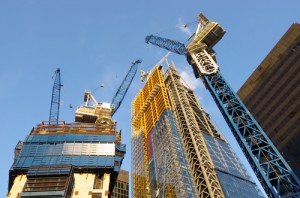City Hall targets construction emissions reduction
Mandatory planning rules to come into effect from September 2015 requiring reduction of emissions from building sites
Building firms operating in London will have to ensure that their construction equipment meets strict pollution standards under new requirements to be introduced by City Hall from next year.
According to the Mayor’s Office, the measure could help to cut construction machinery emissions by up to 40% by 2020 and help London achieve compliance with nitrogen dioxide (NO2) legal limits.
In what has been described by City Hall as a world first, mandatory Supplementary Planning Guidance has been announced which requires construction firms to address emissions of dust, PM10 & PM2.5 particles from sites as well as emissions of nitrogen dioxide from machinery.
The Supplementary Planning Guidance replaces The Control of Dust and Emissions from Demolition and Construction Best Practice Guidance published jointly by London Council’s and the Mayor in 2006. The Mayor held a consultation on a draft of the guidance last October (see airqualitynews.com story).
City Hall claims that other cities and countries have introduced emission requirements for construction machinery before, this is the first time any city has introduced rules for both particulate and NOx emissions.
Reductions
Commenting on the launch of the new guidance, Mayor of London Boris Johnson, said: “By replacing the oldest and most polluting bulldozers and machinery on building sites we can greatly reduce harmful emissions and boost our air quality. We’ve all walked past construction sites and seen thick clouds of dust generated from equipment that simply hasn’t been updated or replaced in decades. This new guidance will reduce NOx and is part of a series of strong measures including the Ultra Low Emission Zone from 2020 that will greatly reduce London’s air pollution from all emission sources.”
City Hall has worked closely with the construction and retrofit industries over the new guidance, which will be implemented from September 2015 by local authorities through the planning system.
Dust guidance
It follows the launch of the Institute of Air Quality Management (IAQM)’s construction dust guidance in February 2014 (see airqualitynews.com story).
Dr Claire Holman from IAQM said of the London City Hall guidance: “This is an important step in reducing emissions from demolition and construction sites that are both annoying and damaging to human health. These standards have rightly taken into account the impact on air quality and will be a key part of the planning process of new developments.”
Tighter standards will be put in place in central London, due to the ‘greater scale and impact’ of construction in this area. The standards will tighten again across the whole of London in 2020 to work alongside the Mayor’s proposals for an Ultra Low Emission Zone in central London.







 Network
Network
